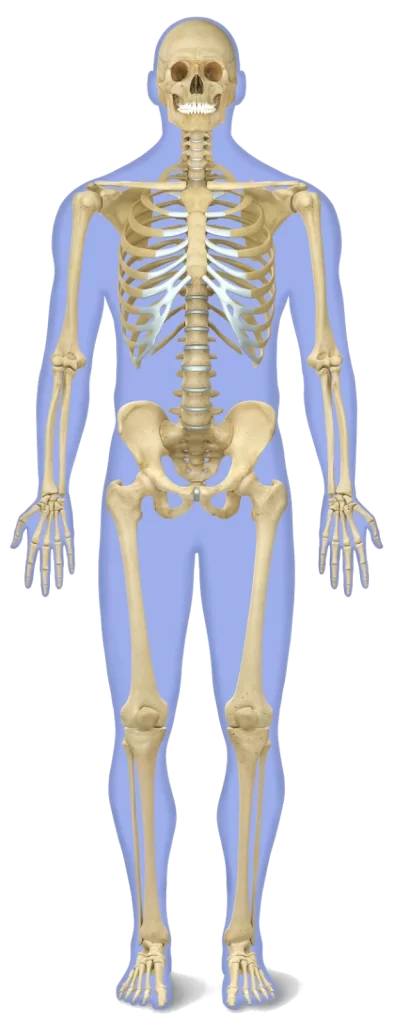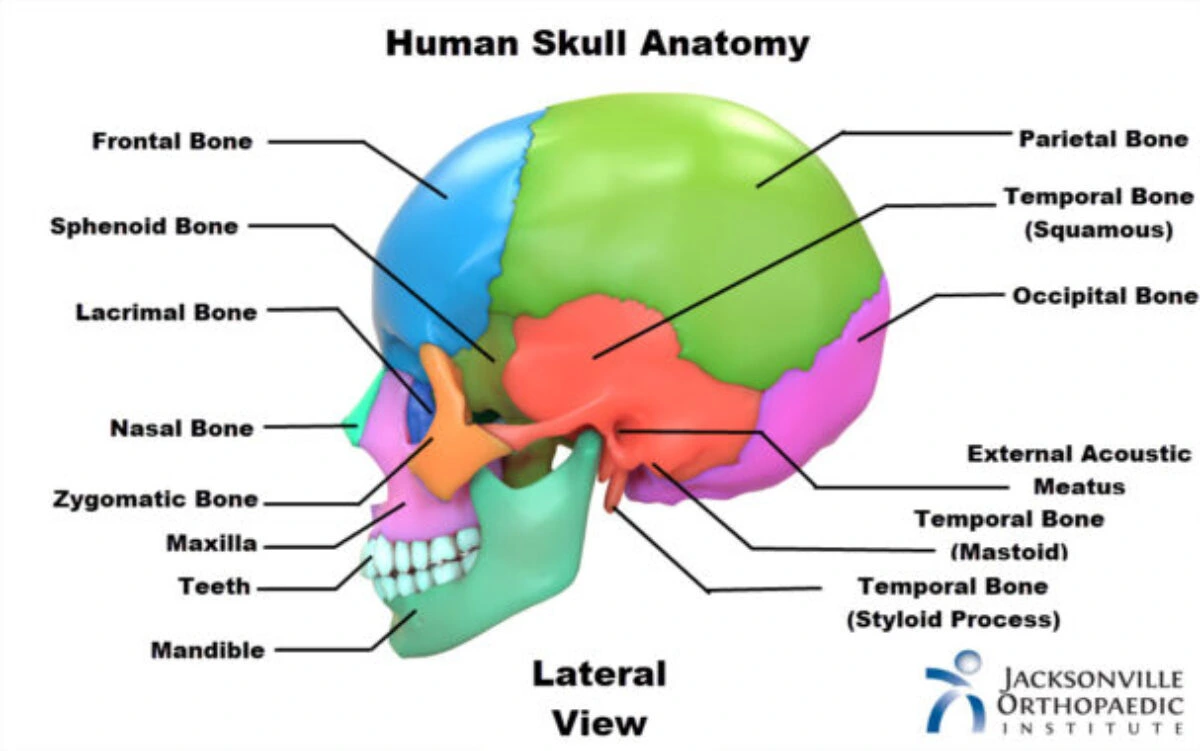How Many Bones Are There In The Human Body?

Number of Bones In Human As Baby
The number of bones in the human body varies between a baby and an adult. At birth, a baby typically has around 270 bones. However, as the baby grows, some of these bones fuse together. The journey from infancy to adulthood involves significant changes in bone structure. Understanding the developmental aspects of bones provides insights into growth patterns.
Number Of Bones In Adult Human Body
By the time a person reaches adulthood, the number of bones in the human body averages around 206. The process of bone fusion during growth contributes to the reduction in the total number of bones from infancy to adulthood.
Types Of Bones In The Human Body
These bones are divided into two main categories:
1. Axial Bones: The axial skeleton consists of 80 bones, which include the skull, vertebral column, and ribcage.
2. Appendicular Bones: The appendicular skeleton consists of 126 bones, which include the bones of the limbs and the girdles that attach them to the axial skeleton.
The skull is composed of 22 bones, including the cranial bones that protect the brain and the facial bones that support the eyes, nose, and mouth. The vertebral column is made up of 33 vertebrae, which provide support and protection to the spinal cord. The ribcage is composed of 12 pairs of ribs, which protect the heart and lungs.
The appendicular skeleton is composed of the bones of the upper and lower limbs and the girdles that attach them to the axial skeleton. The upper limb consists of 30 bones, including the humerus, radius, ulna, carpals, metacarpals, and phalanges. The lower limb consists of 30 bones, including the femur, tibia, fibula, tarsals, metatarsals, and phalanges. The girdles that attach the upper and lower limbs to the axial skeleton are the pectoral girdle and the pelvic girdle, respectively.
In addition to the 206 bones, the human body also contains a number of small, irregularly-shaped bones called sesamoid bones. These bones are found in areas of high stress, such as the kneecap and the base of the thumb.
While the average human body contains 206 bones, there are some variations in the number of bones depending on factors such as age and development. For example, infants are born with more bones than adults, as many of the bones in the skull and the vertebral column have not yet fused together. Over time, these bones fuse together, reducing the total number of bones in the body.
In conclusion, the human body is composed of 206 bones that provide support, protection, and shape to the body. These bones are divided into axial and appendicular bones and are found in the skull, vertebral column, ribcage, and limbs. While the number of bones in the human body can vary depending on age and development, the average adult human body contains 206 bones.
List of 206 Bones OF The Adult Human Body
1. Skull (22 bones):

- 8 cranial bones
- 14 facial bones
2. Ear bones (6 bones):

- 3 ossicles in each ear: malleus, incus, stapes
3. Hyoid bone (1 bone)
4. Spine (26 bones):
- 7 cervical vertebrae
- 12 thoracic vertebrae
- 5 lumbar vertebrae
- 1 sacrum (5 fused vertebrae)
- 1 coccyx (4 fused vertebrae)
5. Chest (25 bones):
- 1 sternum
- 24 ribs (12 on each side)
6. Shoulders (4 bones):
- 2 clavicles (collarbones)
- 2 scapulae (shoulder blades)
7. Arms (6 bones each):
- 1 humerus (upper arm bone)
- 1 radius (forearm bone on thumb side)
- 1 ulna (forearm bone on pinky side)
- 8 carpals (wrist bones)
- 19 metacarpals (palm bones)
- 14 phalanges (finger bones)
8. Pelvis (2 bones):
- 1 left hip bone
- 1 right hip bone
9. Legs (6 bones each):
- 1 femur (thigh bone)
- 1 patella (kneecap)
- 1 tibia (shin bone)
- 1 fibula (calf bone)
- 7 tarsals (ankle bones)
- 19 metatarsals (foot bones)
- 14 phalanges (toe bones)
Overall, these 206 bones work together to provide the structure, support, and mobility necessary for the human body to function properly.
Conclusion
The adult human body generally consists of 206 bones, and when baby 270 bones which form the skeletal framework essential for support, protection, and movement. While there can be slight variations from person to person due to bone fusion during growth, the overall structure and function of the skeletal system play a crucial role in maintaining the body’s form and facilitating various physiological processes.
Created with AIPRM Prompt “Human Written |100% Unique |SEO Optimized Article”
Outline
- Introduction
- Brief overview of the human skeletal system
- Importance of knowing the number of bones
- The Adult Human Skeleton
- Total number of bones in an adult human
- Classification of bones (axial and appendicular)
- Functions of the Skeletal System
- Support and protection
- Movement and locomotion
- Blood cell formation (hematopoiesis)
- Variability in Bone Count
- Individual differences in bone count
- Factors influencing bone structure
- Bones in the Human Skull
- Cranial and facial bones
- Role of the skull in protecting the brain
- Vertebral Column
- Structure and function of vertebrae
- Importance of spinal health
- Appendicular Skeleton
- Bones of the limbs (arms and legs)
- Girdles connecting limbs to the axial skeleton
- Developmental Changes in Bone Count
- Infant skeleton vs. adult skeleton
- Bone growth and development
- Common Misconceptions
- Myths about the number of bones
- Clarification and debunking
- Implications for Health and Well-being
- Importance of bone health
- Effects of bone-related conditions
- Factors Influencing Bone Density
- Nutrition and bone health
- Physical activity and its role
- Bone Disorders and Diseases
- Overview of common bone disorders
- Preventive measures and treatments
- Cultural Significance of Bones
- Rituals and beliefs associated with bones
- Symbolism across cultures
- The Future of Bone Health
- Advances in bone research
- Technologies and treatments on the horizon
- Conclusion
- Recap of key points
- Encouragement for maintaining bone health
How Many Bones are in the Human Body?
Introduction
The human body is a marvel of complexity, and the skeletal system forms its structural foundation. Ever wondered how many bones are in the human body? Join us on a fascinating journey through the intricacies of the skeletal structure, exploring its functions, variability, and cultural significance.
The Adult Human Skeleton
In the average adult human, there are 206 bones. These bones are classified into two main categories: axial, which includes the skull, vertebral column, and rib cage; and appendicular, consisting of the limbs and girdles that connect them to the axial skeleton.
Functions of the Skeletal System
The skeletal system is not just a framework; it plays a crucial role in support, protection, and movement. Bones also serve as sites for blood cell formation, emphasizing their importance in overall health.
Variability in Bone Count
Interestingly, the number of bones can vary among individuals due to factors such as genetics, age, and lifestyle. This variability adds to the uniqueness of each person’s skeletal structure.
Bones in the Human Skull
The human skull comprises cranial and facial bones, offering protection to the brain. Understanding the intricacies of the skull sheds light on its role in safeguarding our most vital organ.
Vertebral Column
The vertebral column, made up of individual vertebrae, provides structural support and flexibility. Maintaining a healthy spine is crucial for overall well-being and mobility.
Appendicular Skeleton
Our limbs, connected to the axial skeleton via girdles, enable us to perform a myriad of activities. Exploring the bones of the arms and legs highlights their importance in daily functioning.
Developmental Changes in Bone Count
The journey from infancy to adulthood involves significant changes in bone structure. Understanding the developmental aspects of bones provides insights into growth patterns.
Common Misconceptions
There are myths surrounding the number of bones in the human body. Let’s debunk these misconceptions and clarify the facts about our skeletal composition.
Implications for Health and Well-being
Maintaining bone health is vital for overall well-being. This section explores the consequences of neglecting bone health and the importance of preventive measures.
Factors Influencing Bone Density
Nutrition and physical activity play pivotal roles in bone density. Discover how these factors contribute to skeletal health and what you can do to promote it.
Bone Disorders and Diseases
An overview of common bone disorders sheds light on the importance of early detection and preventive measures. Stay informed about conditions that can affect your skeletal system.
Cultural Significance of Bones
Bones hold cultural significance across various societies. Delve into the rituals, beliefs, and symbolism associated with bones in different cultures around the world.
The Future of Bone Health
Advancements in bone research and emerging technologies offer hope for the future. Explore what the future holds for bone health and potential breakthroughs in treatment.
Conclusion
In conclusion, understanding how many bones are in the human body is not just a matter of curiosity; it’s a gateway to appreciating the intricate design of our skeletal system. As you navigate through life, remember to take care of your bones—they are the silent architects of your body’s foundation.
FAQs
- How many bones do babies have at birth?
- Babies are born with around 270 bones, but as they grow, some fuse together, resulting in the adult count of 206.
- Can bone density be improved through diet alone?
- While a balanced diet is essential, weight-bearing exercises also play a crucial role in improving and maintaining bone density.
- Are there cultural taboos regarding bones?
- Yes, various cultures have taboos and rituals associated with bones, reflecting their unique perspectives and beliefs.
- What are common signs of bone-related disorders?
- Persistent pain, limited mobility, and deformities are common signs that may indicate bone-related disorders.
- How often should bone density tests be conducted?
- The frequency of bone density tests depends on various factors, including age, gender, and medical history. Consult a healthcare professional for personalized advice.
- Can poor posture affect bone health?
- Yes, maintaining good posture is crucial for spinal health and overall bone well-being. Poor posture can lead to misalignments and discomfort.
- Is bone loss inevitable with aging?
- While bone density tends to decrease with age, adopting a healthy lifestyle, including proper nutrition and regular exercise, can mitigate the effects of bone loss.
- Are there foods that specifically promote bone health?
- Yes, foods rich in calcium, vitamin D, and other minerals are beneficial for bone health. Include dairy products, leafy greens, and fortified foods in your diet.
- What role do hormones play in bone health?
- Hormones, such as estrogen and testosterone, play a significant role in bone density. Hormonal changes, especially during menopause, can affect bone health in women.
- Can genetics influence the risk of bone-related conditions?
- Yes, genetics can contribute to the risk of certain bone disorders. Understanding your family history can help in assessing potential risks and taking preventive measures.
- Are there alternative treatments for bone disorders?
- Depending on the condition, alternative treatments like physical therapy, acupuncture, or dietary supplements may complement conventional medical approaches. Consult with healthcare professionals for personalized advice.
- How does smoking affect bone health?
- Smoking has detrimental effects on bone health, leading to decreased bone density and an increased risk of fractures. Quitting smoking can positively impact overall skeletal well-being.
- Can excessive exercise harm bone health?
- While regular exercise is essential for bone health, excessive or intense workouts without adequate rest can lead to overuse injuries. Balance and moderation are key.
- What is the link between bone health and vitamin K?
- Vitamin K plays a role in bone metabolism and mineralization. Including foods rich in vitamin K, such as leafy greens, contributes to overall bone health.
- At what age is peak bone mass typically reached?
- Peak bone mass is usually achieved by the age of 30. Building and maintaining strong bones during adolescence and early adulthood are crucial for long-term skeletal health.
- The Benefits of Applying Curd On Hair
- How to Cure Lost Voice Overnight? Effective Home Remedies to Cure a Lost Voice Overnight
- How To Cure Lactose Intolerance? Strategies and Lifestyle To Managing Lactose Intolerance
- The Health Benefits of Onion
- 11 Effective Home Remedies for Healing Anal Fissures
- How To Cure Neck Pain Fast At Home Remedies?
- Pumpkin Health Benefits For Women And Men
- How To Eat Chia Seeds | A Guide on How to Eat Chia Seeds for Optimal Nutrition and Flavorful Wellness
- What Is Moringa and its Health Benefits?
- Lion Mane Powder: Lion Mane Powder for Maximum Results, Side Effects
















